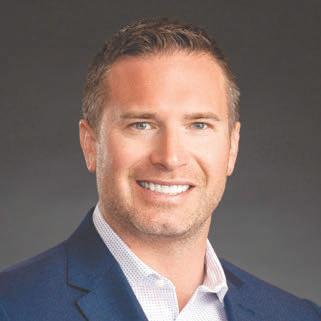
4 minute read
Freeman, Jean von Wittenburg, Denice Spangler Adams, and Dale Lowdermilk
Born London, 1933. Mother Canadian. Father a British civil servant. World War II childhood spent mostly in Toronto and Washington, D.C. Berkeley PhD. in American History, 1964. Living in Santa Barbara since 1973. No children. Best-known for his illustrated epigrams, called “Pot-Shots”, now a series of 10,000. Email ashleigh@west.net or visit www.ashleighbrilliant.com
Hear and Now
The 1964 Simon & Garfunkel song early age, to make greeting cards for “The Sound of Silence” must our family. And I was also influenced seem redolent of an ancient era by my father Victor Brilliant, and his to many of my younger readers – but great love of jokes and wordplay. the haunting melody, combined with Secondly, I offer credit to the masits poetically poignant words, resoterly wordsmiths of the advertising nates as powerfully today as when industry, by whose creations we are the song was born. To me, the part constantly surrounded. I have much which has always been most meaningin common with them, e.g. in trying ful proclaims that “the words of the to pack power into a limited numprophets are written on the subway ber of words. But the main difference walls, and tenement halls.” This has between us is that, unlike me, they are had personal significance in my life, always trying to sell something – while because, not more than three years I have nothing to sell but myself. later, it was my own words (usually Thirdly, as recognized by Simon & on colorful cards) which had begun to Garfunkel, I have derived uplifting appear on walls and halls – at first in inspiration from the anonymous but San Francisco, but then spreading to industrious perpetrators of graffiti, many parts of the world. those “prophets” to whose sometimes
When asked to explain the intellectuvery imaginative works most of us al origins of the type of very short writhave been exposed, often on the walls ing on which I eventually built a whole of very small rooms which provide career, I’ve always cited three major considerable privacy both to the originfluences: First, my parents. My mothinal inscriber and to the subsequent er, Amelia Brilliant, seeing utility in my reader and student. verbal talent, encouraged me, from an But what most people probably remember most inescapably from that anthem of the 1960s was its enduring title and theme: “The Sound of Silence.” And indeed that sound that once so prevalent, has become a precious rarity in our era. Scientists with sensitive instruments have traveled the world in search of truly quiet places, with disappointing results. For the sake of practical needs such as recording or broadcasting, it has been necessary to construct special spaces which are “sound-proof,” in the sense that sounds from outside cannot be heard within. Individuals who want to sound-proof themselves are now confronted with an array of merchandise, ranging from little plugs, of wax or rubber, made for insertion into the ears, to various kinds of apparatuses, like radio headsets, to be worn over the ears. Unfortunately, one drawback of all such devices is that, while providing a certain degree of protection from noise (as measured in decibels, and usually printed on the package) they have no way of distinguishing between unwanted sounds and others, which may be wanted.
Problems with hearing are among the most common accompaniments of aging, and, because governments do not always recognize such ailments as deserving of treatment under any state or national health-care system, a huge, and no doubt highly profitable, hearing aid industry has developed. The fitting, wearing, and maintaining of these devices themselves, however, present such formidable complications that many people who suffer some degree of “hearing loss” prefer to continue hearing imperfectly, rather than going through that whole technological process.
Unfortunately, the ears, unlike the eyes, are not yet as easily operable upon to improve their functioning. And another area in which technology is still surprisingly lagging is noise-suppression. Those of us with hearing loss can still be bothered by noise; in fact, to many such people, the noises become more bothersome. Ironically, there are also situations in which diminishing customary noise has itself become a problem – as in the case of the newer electric cars, which are so quiet that pedestrians who are accustomed to hearing a car coming now face a new danger. In consequence, those cars may be required to make an audible sound – just as the otherwise odorless but poisonous gas we use for cooking has to be given an artificial warning smell.
But the ultimate irony lies in the fact that great songs like “The Sound of Silence” are brought to us through the sonic medium of music. Beethoven, living in silence, was able to write music he could not hear. But he could feel it. Indeed, he was the perfect exponent of the silence of sound. •MJ



Matthew Pifer, MD “Santa Barbara’s Premier Shoulder Expert”
Specializes in Shoulder, Sports Medicine and Biologic Therapies
SERVICES Shoulder Surgery | Knee Surgery | Sports Medicine | PRP Stem Cell | Rotator Cuff Repair | Shoulder Replacement Shoulder Instablility Treatment


Board Certifi ed in Orthopedic Surgery, Specializing in Shoulder, Sports Medicine & Biologics (with an Emphisis in PRP & Stem Cells)

Contact us to schedule an appointment today. 805.967.9311 matthewpifermd.com










